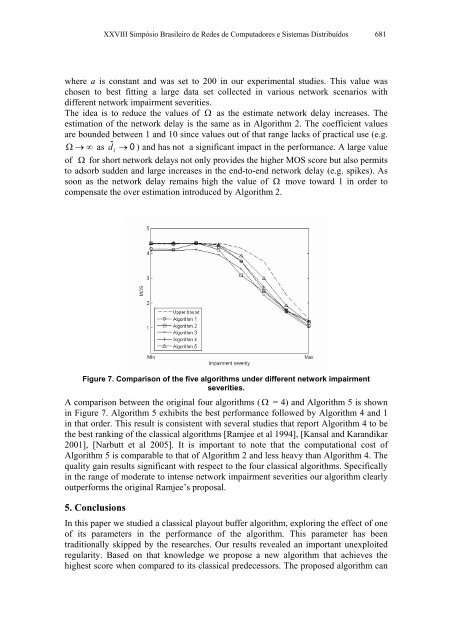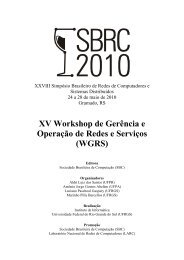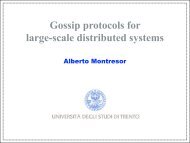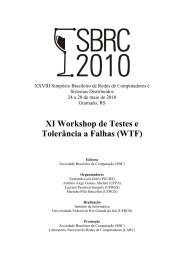Classical Playout Buffer Algorithm Revisited
Classical Playout Buffer Algorithm Revisited
Classical Playout Buffer Algorithm Revisited
Create successful ePaper yourself
Turn your PDF publications into a flip-book with our unique Google optimized e-Paper software.
XXVIII Simpósio Brasileiro de Redes de Computadores e Sistemas Distribuídos 681<br />
where a is constant and was set to 200 in our experimental studies. This value was<br />
chosen to best fitting a large data set collected in various network scenarios with<br />
different network impairment severities.<br />
The idea is to reduce the values of Ω as the estimate network delay increases. The<br />
estimation of the network delay is the same as in <strong>Algorithm</strong> 2. The coefficient values<br />
are bounded between 1 and 10 since values out of that range lacks of practical use (e.g.<br />
Ω → ∞ as d ˆ → i 0 ) and has not a significant impact in the performance. A large value<br />
of Ω for short network delays not only provides the higher MOS score but also permits<br />
to adsorb sudden and large increases in the end-to-end network delay (e.g. spikes). As<br />
soon as the network delay remains high the value of Ω move toward 1 in order to<br />
compensate the over estimation introduced by <strong>Algorithm</strong> 2.<br />
Figure 7. Comparison of the five algorithms under different network impairment<br />
severities.<br />
A comparison between the original four algorithms ( Ω = 4) and <strong>Algorithm</strong> 5 is shown<br />
in Figure 7. <strong>Algorithm</strong> 5 exhibits the best performance followed by <strong>Algorithm</strong> 4 and 1<br />
in that order. This result is consistent with several studies that report <strong>Algorithm</strong> 4 to be<br />
the best ranking of the classical algorithms [Ramjee et al 1994], [Kansal and Karandikar<br />
2001], [Narbutt et al 2005]. It is important to note that the computational cost of<br />
<strong>Algorithm</strong> 5 is comparable to that of <strong>Algorithm</strong> 2 and less heavy than <strong>Algorithm</strong> 4. The<br />
quality gain results significant with respect to the four classical algorithms. Specifically<br />
in the range of moderate to intense network impairment severities our algorithm clearly<br />
outperforms the original Ramjee’s proposal.<br />
5. Conclusions<br />
In this paper we studied a classical playout buffer algorithm, exploring the effect of one<br />
of its parameters in the performance of the algorithm. This parameter has been<br />
traditionally skipped by the researches. Our results revealed an important unexploited<br />
regularity. Based on that knowledge we propose a new algorithm that achieves the<br />
highest score when compared to its classical predecessors. The proposed algorithm can







